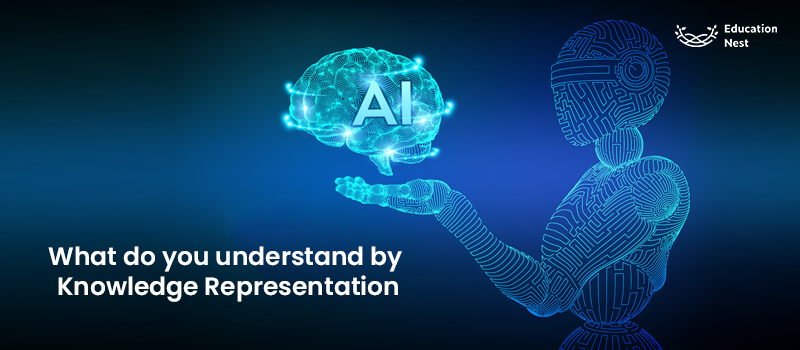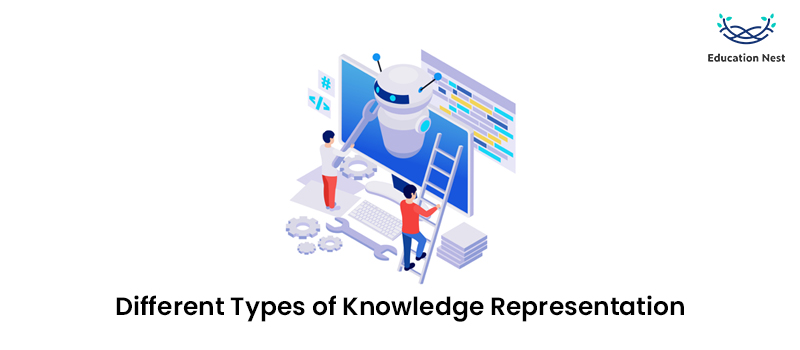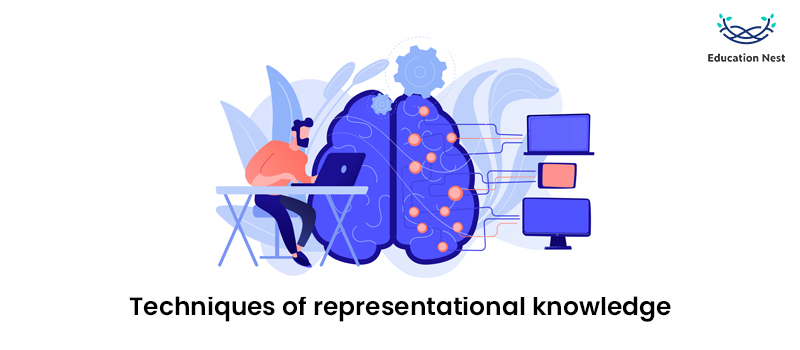Knowledge Representation in AI aims to provide computers with the ability to recognize and categorize data like humans do by relying on their acquired knowledge. In this AI blog, we’ll explain how knowledge representation works so that computers can put that information to use. After reading this post, you will better grasp knowledge representation and reasoning and their kinds and features.
Firstly, let’s understand what knowledge representation is.
What do you understand by “Knowledge Representation”?

Humans excel at logically deriving, comprehending, analysing, and interpreting the world around them. We have learned to adapt to and deal with the challenges we face. However, how can we program robots to mimic human behaviour? The knowledge representation part of artificial intelligence will eventually let robots understand and answer questions asked by humans. The field of artificial intelligence (AI), devoted to the study of knowledge representation, aims to create self-aware robots with the ability to reason autonomously and articulate their beliefs, intentions, and judgements in various contexts.
“Knowledge Representation,” often shortened to “KR” or “KRR” (for “Knowledge Representation and Reasoning“), is the way information from the real world is represented and used to make sense of and solve complex problems. Natural language interaction with humans to answer questions is one such instance. This is more than just putting information into a database; it lets robots learn from real-world experience and act as smartly as their human counterparts.
Categorization of ‘knowledge’:
There are two primary kinds of knowledge:
- Tacit knowledge
- Explicit knowledge
Tacit knowledge is the knowledge that lives inside a human being. It does match up with the knowledge that is not formal or explicit. Elevated expression, as well as communication and sharing, are pretty challenging for tacit knowledge.
Explicit knowledge is information that is out there in the world and not just in people’s heads. The level of knowledge it represents is formal. Information that can be put into words is far more transferable, usable, and manageable than tacit knowledge.
Let us learn about various kinds of knowledge representation in AI.
Different Types of Knowledge Representation

Declarative Knowledge:
Information about the outside world is the only part of knowledge that has stayed the same over time. The purpose of this kind of information is to show the relationships between all of these things, events, or processes.
Procedural Knowledge:
This information, also called “prescriptive knowledge,” is more specific than “declarative knowledge.” It may serve as a public proclamation of success in a particular endeavour. Modern mobile robots often use this method. It lets them plan an attack inside a building or move around a room strategically. If you have a modern robot with declarative knowledge, only a map instead of a complete plan for how to attack a building, it would only know where to go.
Meta Knowledge:
“Meta knowledge” refers to knowledge about knowledge. Metaknowledge includes studying topics such as planning, labelling, and learning. This model is dynamic and is often updated to a newer standard. The following are examples of meta-knowledge that a knowledge engineer could use:
- Accuracy,
- Applicability,
- Assessment,
- Consistency,
- Completeness,
- Disambiguation,
- Justification,
- Life Span,
- Purpose,
- Source,
- Reliability.
Heuristic Knowledge:
Shallow knowledge, which relies on the rule of thumb, is another name for this kind of information. It works well at the reasoning stage because it can answer questions by referring to data from past cases or data made by professionals. It offers insight gained through dealing with similar issues in the past.
Structural Knowledge
You can’t solve any problems without knowing this essential information. It looks for connections between ideas and real-world things.
Lastly, let’s discuss the techniques of knowledge representation in AI.
You Must Watch: Artificial Intelligence for a Better Future: A Collection of its Benefits
Techniques of representational knowledge

The four main methods of AI knowledge representation are as follows:
Logical Representation:
Its syntax and meaning are clear, which makes it the most common way for AI devices to store knowledge. The use of prepositions does not need a dictionary definition. It serves as a communication rule and can be implemented when expressing facts to a computer; this logic has two kinds: propositional and first-order. First-order logic, also known as First Order Predicate Calculus Logic (FOPL), is an advanced form of propositional logic that uses quantifiers and predicates to explain things. It is based on a boolean, or true or false, manner of reasoning.
Advantages of logical representation:
- It helps think logically in knowledge representation.
- It serves as the basis for all formal languages of computation.
Disadvantages of Using Logical Representation:
- It is tough to work on and comes with a few constraints.
- It’s possible that it won’t seem natural and that inferences won’t be fast enough for actual applications.
Semantic Network Representation:
A data network’s semantic network provides a graphical representation of the items’ relationships and functions. It shows the connections between nodes (or blocks) and what they stand for with arcs (or edges). Similar to First-Order Predicate Logic (FOPL), this option includes two types: inheritance and instance.
Advantages of Semantic Network Representation:
- True-to-life portrayal
- Clearly expresses what it means
- Very basic and straightforward to grasp
Disadvantages of semantic network representation:
- A more extended period of calculation is needed
- Not enough detail was provided, and no suitable alternatives were offered.
- Lacking in intelligence and reliant on the AI’s programmer
Frame Representation:
An entity record is a data structure that stores information on an object inside the real world using a set of characteristics and associated values. They are the basis for AI’s ability to separate data into different domains by using stereotypes to represent specific cases. Facets can be of any form and can be assigned any value in any position.
Advantages of Frame Representation:
- The necessary code will be much simpler if the relevant data is grouped.
- Very simple and easy to picture
- New connections may be added quickly and easily.
- Simple to fill in using defaults and search for missing information.
Disadvantages of Frames in Artificial Intelligence:
- One cannot readily process this method.
- There will be hiccups in the inference procedure.
- An approach that may be used in many different situations
Production Rules:
In this method, the agent looks for a predetermined condition and takes the right action based on the production rule if it finds it. Laws that can be used in a specific situation will be written in the “condition” section, and the actions associated with those laws will be written in the “action” section. Therefore, the sequence is classified as an “established act cycle.” The three main components of the production rule are the production rule set, processing speed, and the recognise-act-cycle.
Advantages of Production Rules:
- It may be stated using standard language
- Extremely reusable and modifiable
Disadvantages of Production Rules:
- There is no evidence of learning abilities.
- The problem’s answer is not stored anywhere for later use.
- During the program’s execution, several rules will be triggered.
- Cumbersome regulations hamper the manufacturing process.
In artificial intelligence, knowledge representation teaches robots how to act in a given circumstance—taking advanced courses in artificial intelligence will teach you how to use it to solve practical issues.
